Related Research Articles
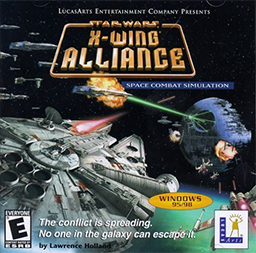
Star Wars: X-Wing Alliance is a space simulation video game, the sequel to both Star Wars: TIE Fighter and Star Wars: X-Wing vs. TIE Fighter. X-Wing Alliance presents the story of the Azzameen family, a family of space traders. The player assumes the role of Ace Azzameen, the youngest of the Azzameen children, juggling military duty as a fighter pilot for the Rebel Alliance, and allegiance to his family, flying larger heavily armed freighters for the family business, amid a bloody family feud and in the larger context of a galactic civil war. It received favorable reviews.

Star Control: Famous Battles of the Ur-Quan Conflict, Volume IV is an action-strategy video game developed by Toys for Bob and published by Accolade. It was originally released for MS-DOS and Amiga in 1990, followed by ports for the Sega Genesis and additional platforms in 1991. The story is set during an interstellar war between two space alien factions, with humanity joining the Alliance of Free Stars to defeat the invading Ur-Quan Hierarchy. Players can choose to play as either faction, each with seven different alien starships which are used during the game's combat and strategy sections.
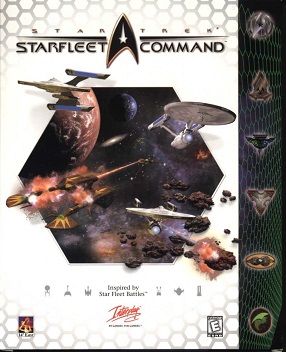
Star Trek: Starfleet Command is a computer game based on the table-top wargame Star Fleet Battles. It was developed by 14° East and Quicksilver Software and published by Interplay Entertainment. It was released in 1999 for Microsoft Windows. It simulates starship operations, ship-to-ship combat, and fleet warfare in the Star Trek universe. An expanded version was released in 2000 titled Star Trek: Starfleet Command - Gold Edition. It includes the latest patch and all the missions that were downloadable from the official website.

Star Wars: Rebel Assault is a 1993 rail shooter video game developed and published by LucasArts for DOS, Macintosh, Sega CD and 3DO Interactive Multiplayer systems, set in the Star Wars universe. It is the first CD-ROM-only game to be published by LucasArts. The game's story focuses on a young pilot called Rookie One as they are trained by, and subsequently fights for, the Rebel Alliance in the Galactic Civil War.

Star Wars: Rebel Assault II: The Hidden Empire is a 1995 video game developed by LucasArts. It is the sequel to Star Wars: Rebel Assault, set in the Star Wars expanded universe. It is played as a rail shooter; the player proceeds down predetermined paths, but has the ability to control aiming, shooting, and dodging. The player character, Rookie One, pilots ships such as a YT-1300 Corellian Transport, a B-wing, and a Y-wing, and encounters new enemy ships, including TIE Interceptors. They uncover, and eventually disable production of, a new TIE variant known as the TIE Phantom, which has the ability to cloak.
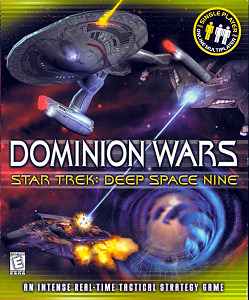
Star Trek: Deep Space Nine: Dominion Wars is a 2001 space combat/real-time tactics video game for Microsoft Windows developed by Gizmo Industries and published by Simon & Schuster. The game is based on the Star Trek TV show Star Trek: Deep Space Nine.
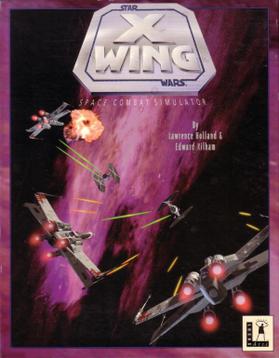
Star Wars: X-Wing is a space simulation video game, the first of the X-Wing combat flight simulation games series. The player's character flies starfighters, including the X-wing, for the Rebel Alliance. The narrative precedes and parallels the events of Star Wars Episode IV: A New Hope.

Master of Orion II: Battle at Antares is a 4X turn-based strategy game set in space, designed by Steve Barcia and Ken Burd, and developed by Simtex, who developed its predecessor Master of Orion and Master of Magic. The PC version was published by MicroProse in 1996, and the Macintosh version a year later by MacSoft, in partnership with MicroProse. The game has retained a large fan base, and is still played online.

Star Trek Starfleet Command II: Empires at War is the sequel to Star Trek: Starfleet Command and the second in the series of real-time space combat games, developed by Taldren, Inc. and published by Interplay. A stand-alone expansion pack was released in June 2001 titled Starfleet Command: Orion Pirates.
Star Trek: Legacy is a 2006 real-time tactics space combat video game for Microsoft Windows and Xbox 360 developed by Mad Doc Software and published by Bethesda Softworks in association with CBS Paramount Television and CBS Consumer Products. Originally slated for release in the fall of 2006 to coincide with the 40th anniversary of Star Trek, the Windows version was not released in North America until December 5, 2006, and the Xbox 360 version until December 15. In Europe, both the PC version and the Xbox 360 version were released on December 22, 2006.
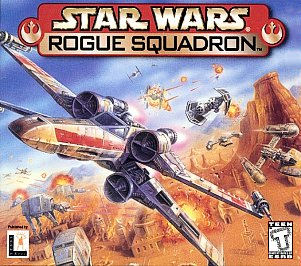
Star Wars: Rogue Squadron is an arcade-style flight action game co-developed by Factor 5 and LucasArts. The first of three games in the Rogue Squadron series, it was published by LucasArts and Nintendo and released for Microsoft Windows and Nintendo 64 in December 1998. The game's story was influenced by the Star Wars: X-wing – Rogue Squadron comics and is set in the fictional Star Wars galaxy, taking place primarily between events in the films Star Wars and The Empire Strikes Back. The player controls Luke Skywalker, commander of the elite X-wing pilots known as Rogue Squadron. As the game progresses, Skywalker and Rogue Squadron fight the Galactic Empire in 16 missions across various planets.
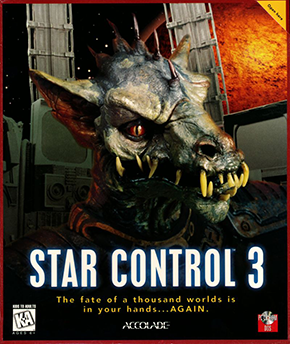
Star Control 3 is a 1996 action-adventure game developed by Legend Entertainment and published by Accolade. The third installment in the Star Control trilogy, the game was released for MS-DOS in 1996 and Mac OS in 1998. The story takes place after Star Control II, beginning with a disaster that disrupts superluminal travel through hyperspace. This leads the player to investigate a new quadrant of space, joined by allied aliens from the previous games.
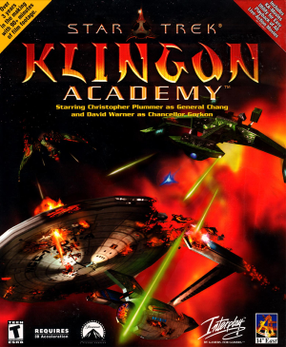
Star Trek: Klingon Academy is a space flight simulator video game developed by 14 Degrees East, an internal development house of publisher Interplay Entertainment. The game follows a young Klingon warrior named Torlek as he attends the Elite Command Academy, a war college created by General Chang to prepare warriors for a future conflict with the United Federation of Planets. Christopher Plummer and David Warner reprised their respective roles as Chang and Gorkon for the production of Klingon Academy.

Star Trek: Encounters is a video game set in the Star Trek fictional universe, which was released in 2006 for the PlayStation 2. The game was developed by Scottish studio 4J Studios for Bethesda Softworks and Ubisoft (EU).

Evochron Alliance is a shareware First Person 3D Space Combat & Mercenary Simulation Windows game by American indie developer StarWraith 3D Games and sequel to Evochron. It features zero gravity inertia based 'Newtonian' style flight model with complete 3-way rotation and 3-way direction control.
StarWraith is a series of space combat simulators by StarWraith 3D Games.
Shadow Squadron is a space combat simulation video game developed and published by Sega exclusively for the 32X add-on first in Japan on 26 April 1995, then in North America and Europe in June of the same year.

Star Wraith IV: Reviction (2004–2005) is the last game bearing the Star Wraith title in the Star Wraith 3D Games series. It was released together with Riftspace, a freeform mercenary game. While having many resemblances to Star Wraith: Shadows of Orion, Star Wraith IV had a linear campaign and far more capable multiplayer capabilities. It quickly became one of the most popular online games in the series, until Arvoch Conflict was released in 2006.
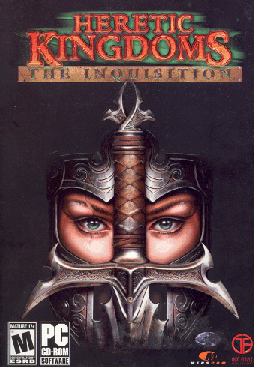
Kult: Heretic Kingdoms is an isometric role-playing video game, combining 3D technologies with the intuitive environment of an isometric game. It was developed by Slovak studio 3D People, with a storyline written by a script team that includes Chris Bateman and game mechanics designed by the International Hobo team. It was published in North America as Heretic Kingdoms: The Inquisition. On February 27, 2014, the successor of Kult was announced: Shadows: Heretic Kingdoms is the next chapter in the Heretic Kingdoms series.

Warcraft II: Tides of Darkness is a fantasy real-time strategy computer game developed by Blizzard Entertainment and released for MS-DOS and Microsoft Windows in 1995 and Mac OS in 1996 by Blizzard's parent, Davidson & Associates. A sequel to Warcraft: Orcs & Humans, the game was met with positive reviews and won most of the major PC gaming awards in 1996. In 1996, Blizzard released an expansion pack, Warcraft II: Beyond the Dark Portal, for DOS and Mac OS, and a compilation, Warcraft II: The Dark Saga, for the PlayStation and Sega Saturn. The Battle.net edition, released in 1999, included Warcraft II: Beyond the Dark Portal, provided Blizzard's online gaming service, and replaced the MS-DOS version with a Windows one.